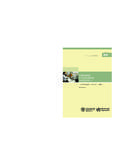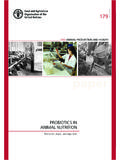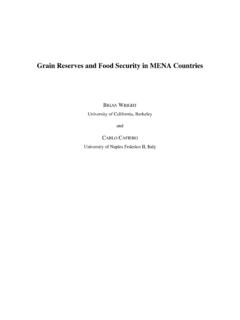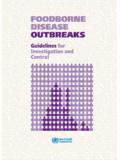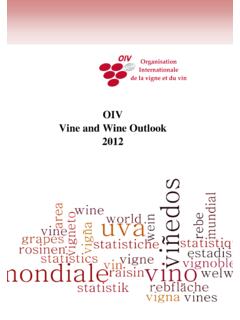Transcription of Essential environmental health standards in health …
1 Essential environmental health standards in health care Edited by John Adams, Jamie Bartram, Yves Chartier WHO Library Cataloguing-in-Publication Data world health organization . Essential environmental health standards in health care Edited by John Adams, Jamie Bartram, Yves Chartier health standards . facilities standards . facilities organization and administration. policy. standards . countries. I. Adams, John. II. Bartram, Jamie. III. Chartier, Yves. ISBN 978 92 4 154723 9 (NLM classification: WX 140). world health organization 2008. All rights reserved. Publications of the world health organization can be obtained from: WHO Press, world health organization 20 Avenue Appia 1211 Geneva 27, Switzerland Tel: +41 22 791 2476. Fax: +41 22 791 4857. Email: Requests for permission to reproduce or translate WHO publications whether for sale or for non-commercial distribution should be addressed to WHO Press at the above address (fax: +41 22 791 4806; e-mail: The designations employed and the presentation of the material in this publication do not imply the expression of any opinion whatsoever on the part of the world health organization concerning the legal status of any country, territory, city or area or of its authorities, or concerning the delimitation of its frontiers or boundaries.)
2 Dotted lines on maps represent approximate border lines for which there may not yet be full agreement. The mention of specific companies or of certain manufacturers' products does not imply that they are endorsed or recommended by the world health organization in preference to others of a similar nature that are not mentioned. Errors and omissions excepted, the names of proprietary products are distinguished by initial capital letters. All reasonable precautions have been taken by the world health organization to verify the information contained in this publication. However, the published material is being distributed without warranty of any kind, either express or implied. The responsibility for the interpretation and use of the material lies with the reader. In no event shall the world health organization be liable for damages arising from its use. The named authors alone are responsible for the views expressed in this publication.
3 Printed in India Designed by Design ONE, Canberra, Australia The cover photographs are (top to bottom):latrines ( world Bank), child washing ( world Bank), hospital (Carmem Pessoa-Da-Silva), child drinking ( world Bank), woman washing ( world Bank), health -care facility (Yves Chartier). 2. Foreword health -care associated infections contribute to morbidity and mortality, and to a loss of health -sector and household resources worldwide. Five to thirty per cent of patients develop one or more infections during a stay in hospital a significant proportion of which could be avoided. In crises or precarious situations, the number of infections worsens. In some circumstances, people may choose not to seek care because the nearest facilities are not functioning or because treatment is uncertain due to shortages of water, electricity or supplies. Unsafe health -care settings contribute to a significant proportion of some diseases.
4 Legionellosis is a well-established risk associated with health -care facilities, with an average proportion of health -care associated infections close to 10%. Sharps waste, although produced in small quantities, is highly infectious. Contaminated needles and syringes represent a particular threat because they are sometimes scavenged from waste areas and dump sites, and reused. If poorly managed, they expose health -care workers, waste handlers and the community to infections. The problem of diseases from unsafe health -care settings is growing worse. Worldwide, there is increasing provision of health care, which is also becoming more complex. Furthermore, an increasing proportion of the population is immunocompromised (and therefore more susceptible to health -care related infection). Without effective action, the situation is likely to deteriorate. health -care settings include hospitals, health centres, clinics, dental surgeries and general practitioner facilities.
5 They provide an opportunity to educate visitors and the general population about minimizing disease transmission by providing targeted messages and a model safe environment. Messages can also contribute to a safe home environment, which is especially relevant to the trend towards increased home-based care in both developing and developed countries. The development and implementation of national policies, guidelines on safe practices, training and promotion of effective messages in a context of healthy medical facilities will decrease the number of infections associated with health -care settings. The international policy environment increasingly reflects the problem of health -care associated infections. The eight United Nations (UN) Millennium Development Goals1. include goals on maternal health (there are an estimated 529 000 maternal deaths per year), as well as other goals relating to major diseases and infant mortality.
6 At the same time, the UN Millennium Project2 and the UN Secretary-General have highlighted the importance of rapidly addressing quick wins ; that is, identifying specific ways of providing health services to health -care facilities. Guidelines on environmental health in health care are universally available, but additional guidance for precarious situations is needed. 1. 2. 3. This document deals specifically with Essential environmental health standards required for health -care settings in medium- and low-resource countries to: assess prevailing situations and plan the improvements that are required develop and reach Essential safety standards as a first goal support the development and application of national policies. These guidelines have been written for use by health managers and planners, architects, urban planners, water and sanitation staff, clinical and nursing staff, carers and other health -care providers, and health promoters.
7 4. C o n t e n ts Foreword ..3. Acknowledgements ..7. Abbreviations and 1 Purpose, scope and audience ..11. Policy health rationale ..13. health -care settings ..14. Large health -care settings ..14. Small health -care settings ..14. Emergency or isolation settings ..14. Structure ..15. 2 Implementation ..17. Positive policy environment ..17. Steps in managing standards at national, district and local Roles and responsibilities ..19. Coordination in the health -care Using the guidelines to create standards for specific health -care Assessing and planning minimum Phased Technology choice, operation and Ongoing monitoring, review and correction ..22. Staff requirements and training ..22. Hygiene 5. 3 Guidelines for setting environmental health Guidelines and associated Guideline Guidance 4 Assessment checklist ..47. 5 Glossary ..53. 6 Further reading ..55. 6. A c k n o w l e d g e m e n ts The world health organization (WHO) wishes to express its appreciation to all whose efforts made the production of this document possible.
8 In particular, WHO gratefully acknowledges the contributions of the following experts, who contributed to and reviewed these guidelines. John Adams Visiting Lecturer, Liverpool School of Tropical Medicine Liverpool, United Kingdom Roger Aertgeerts Regional Adviser, Water and Sanitation, European Centre for Environment and health WHO Regional Office for Europe, Roma, Italy Sheila Anazonwu Communications and Development Programme Officer, International Hospital Federation Ferney Voltaire, France Jamie Bartram Coordinator, Programme on Assessing and Managing environmental Risks to health WHO Headquarters, Geneva, Switzerland Yves Chartier Public health Engineer, Programme on Assessing and Managing environmental Risks to health WHO Headquarters, Geneva, Switzerland Mohd Nasir Hassan Programme of environmental health WHO Regional Office for Western Pacific, Phnom Penh, Cambodia Nathalie Isouard Hygiene hospital technical adviser M decins Sans Fronti res, Barcelona, Spain Peter Maes Coordinator.
9 Department of Water and Sanitation M decins Sans Fronti res, Brussels, Belgium Shaheen Mehtar Head of Academic Unit for Infection Prevention and Control Tygerberg Hospital & Stellenbosch University, Cape Town, Republic of South Africa Catherine Noakes Pathogen Control Research Group, School of Civil Engineering University of Leeds, Leeds, United Kingdom 7. Jackie Sims Technical Officer, Programme on Assessing and Managing environmental Risks to health WHO Headquarters, Geneva, Switzerland U Kyaw Win Deputy Director, environmental Sanitation Division Department of health , Yangon, Myanmar Raki Zgondhi Urban health and Environment WHO Regional Centre for environmental health Activities, Amman, Jordan The development of this publication was made possible with the support and collaboration of the Australian Government's overseas aid programme (AusAID), the United Kingdom Department for International Development, the Swedish International Development Cooperation Agency and the world Patient Safety Alliance.
10 8. Abbreviations and acronyms DPD N,N-diethyl-p-phenylenediamine FAO Food and Agriculture organization of the United Nations HBV hepatitis B virus HCV hepatitis C virus HCS health care setting HEV hepatitis E virus HIV human immunodeficiency virus NTU nephelometric turbidity units SARS severe acute respiratory syndrome UN United Nations WHO world health organization 9. 1 Introduction Purpose, scope and audience Essential environmental health standards in health care contains guidelines for setting standards of safety conditions to provide adequate health care. This document also recommends measures for minimizing the risk of health care-associated diseases for patients, staff and These guidelines have been written for use by health managers and planners, architects, urban planners, water and sanitation staff, clinical and nursing staff, carers and other health -care providers, and health promoters.










